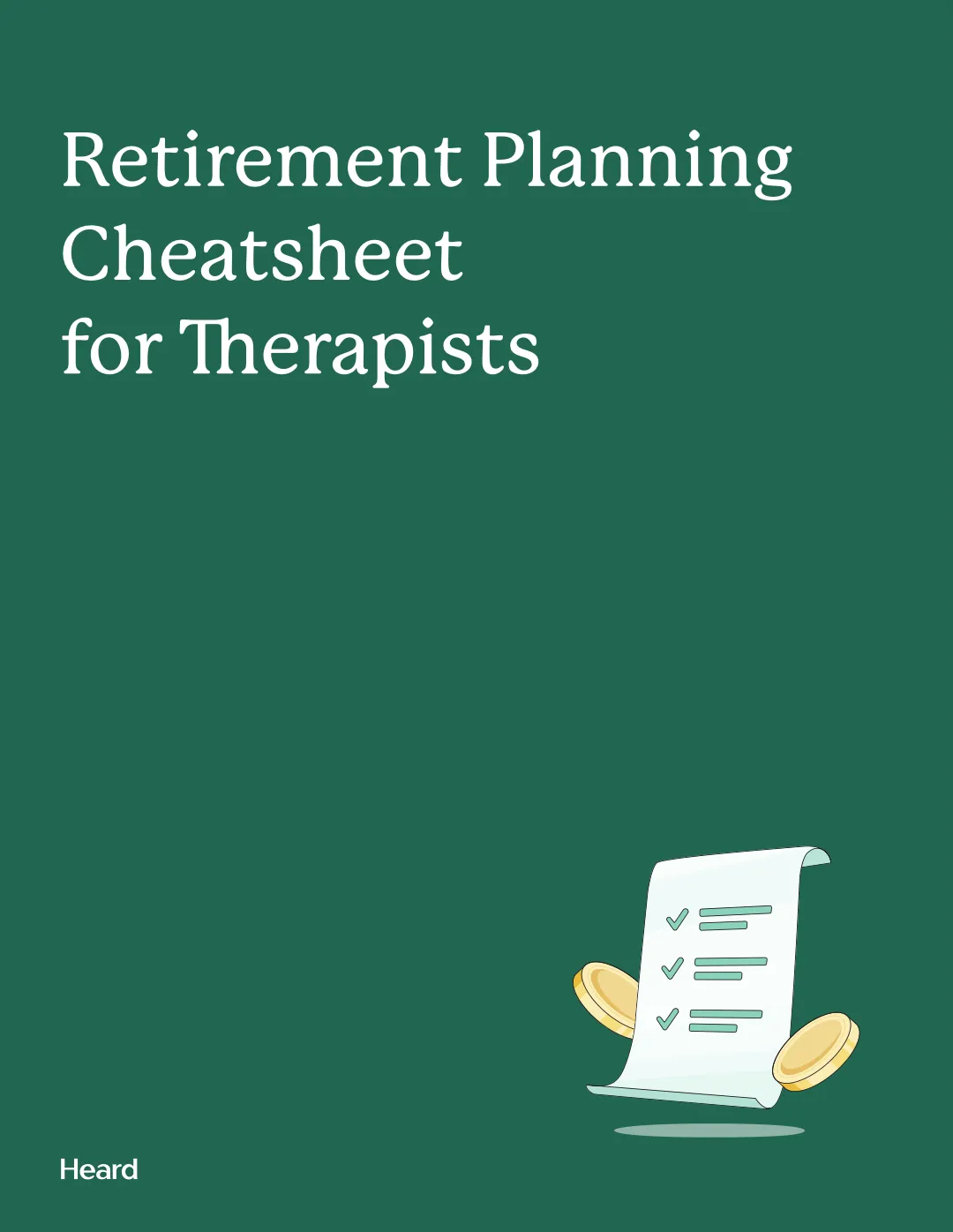Setting up a retirement plan for your therapy practice helps attract and retain dedicated employees. More importantly, it allows the people working for your practice to take concrete steps planning their futures.
Even if you don’t have any employees, you can set up a retirement plan for your therapy practice now and immediately begin setting aside funds and even deferring some of your income tax.
Below, you’ll learn about the different types of retirement plans available to therapy practice owners, as well as the factors you should consider before deciding on the right one for you.
{{resource}}
A quick disclaimer
This article covers the different types of plans available, but it doesn’t tell you which company to set one up with.
If we were to recommend a specific company, it would be Guideline. Heard has partnered with Guideline to offer simple and straightforward retirement plans to therapists. Learn more about Heard’s partnership with Guideline and how you can benefit.
Why set up a retirement plan for your therapy practice?
Whether you’re setting up one up for employees or solely for your own use, a retirement plan comes with numerous benefits, including:
- Access to emergency funds. In the event of disability or illness, unexpected medical bills, or other setbacks, you may be able to withdraw funds from your retirement plan to help cover financial shortfalls.
- Tax deferrals. Retirement plans like traditional IRAs allow you to make tax exempt contributions, paying income tax only when you withdraw the funds in retirement.
- Peace of mind. It’s impossible to know exactly what will come to pass between today and the day you retire, but having a retirement plan set up means you’ve at least taken the first step making sure you’ll be supported once you can no longer work.
Types of retirement plans for your therapy practice
Retirement plans can be split up into three categories:
- Defined benefit plans, which give employees a specified monthly or yearly amount once they have retired. In most cases, employers define this as a percentage of the employee’s salary. Traditional pensions—which are becoming increasingly less common—fall into this category.
- Defined contribution plans, which don’t specify a particular amount received by the employee after retirement. Rather, both the employee and the employer contribute to the plan. Once the employee retires, the total amount becomes available to them. The 401(k) is the most well-known defined contribution plan.
- Individual Retirement Accounts, which include many options for self-employed people. They allow you to set aside money for the future while enjoying tax advantages.
Defined benefit plans for therapy practices
Traditional pensions, whereby an employer commits to contributing a certain amount of money to a pool of assets, are increasingly rare. Only 15% of employees in the private sector today have defined benefit plans.
That’s partly because less expensive options are available. It costs a company less to set up its employees with a 401(k), for example, than to give them a pension. Other options, such as IRAs, offer more flexibility.
Compared to defined contribution plans and IRAs, pensions also cost more to set up and maintain. In most cases, setting up a pension is not a realistic choice for a small therapy practice.
401(k) plans for therapy practices
With a 401(k), an employee has the option of differing a portion of their income to their retirement savings account, where it’s invested according to conditions they set. Their employer, in turn, may agree to contribute funds to the account—typically either a fixed amount or a percentage of the employee’s contributions.
There are different types of 401(k)s. How an employee’s deferred income is taxed depends on what kind of 401(k) they have:
- Traditional 401(k): The deferred income is not taxed at the time it is earned. Instead, when the employee retires or reaches 59 ½ years of age, they can withdraw funds from their 401(k) without incurring an early withdrawal penalty. At that point, the funds withdrawn are taxed at the employee’s current tax rate. This is beneficial if, after retirement, the employee is in a lower tax bracket than they were when they made the contribution.
- Roth 401(k): The deferred income is taxed at the employee’s current tax rate before being put in the 401(k). After age 59 ½ or retirement, when the employee withdraws the money, it is not taxed.
- Profit sharing 401(k): An employee is able to make contributions to their retirement plan, while their employer can contribute an amount determined by the profits of the company.
- Safe harbor 401(k): The employer must contribute at least a 3% contribution to all participants’ plans. This allows the employer to forego annual nondiscrimination testing, reducing their administrative burden.
- Automatic enrollment 401(k): Every employee eligible for a 401(k) is enrolled automatically, with a set amount deferred from their income each year. Employees may choose to opt out.
- Solo 401(k): This type of plan is ideal for solo therapists running their own practices. It costs less to set up than other types of 401(k), and does not require annual nondiscrimination testing. In order to qualify, the business owner must be the only person at the company who meets eligibility requirements (eg. working at least 1,000 hours per year).
IRA-based plans for therapists
If your therapy practice is just starting out, and you don’t have any employees, an IRA may be a good choice. It’s fairly simple and inexpensive to set up and run, and if you’re quitting another job in order to set out on your own, you can roll your pre-existing 401(k) forward into your new IRA.
When you open an IRA, you have a wide range of investments to choose from, including stocks, bonds, mutual funds, and EFTs. The contribution limit to your IRA is a maximum dollar amount; it can change year to year, and depends on the type of IRA you have.
Here are the most common types of IRAs available to self-employed therapists:
- Traditional IRA: Any contribution to a traditional IRA is tax deductible—meaning, you don’t have to pay income taxes on it. When you withdraw the funds, it is taxed at your tax rate for that particular year.
- Roth IRA: Your contributions to a Roth IRA are after-tax. That means any income you contribute is taxed at your current tax rate. When you withdraw the funds, however, they are not taxed again.
- SEP IRA (Simplified Employee Pension Individual Retirement Arrangement): A SEP IRA operates in much the same way as a traditional IRA. Employers can make contributions to their employees’ SEP IRA accounts—the contributions are tax deductible—but the employees themselves may not.
- Savings Incentive Match Plan for Employees (SIMPLE) IRA: A SIMPLE IRA is similar to a SEP IRA, the main difference being that employees can make tax-deductible contributions, which employers match.
{{resource}}
Important factors when choosing a retirement plan for your therapy practice
A financial advisor can steer you in the right direction when choosing a retirement plan for your therapy practice. Before setting up a meeting, ask yourself the following:
- How many employees do you intend to have on the plan? If the plan is currently just for you, do you intend to add employees in the future?
- Would you like to be able to match employees’ contributions to the plan?
- Do you expect your income bracket to be higher or lower after retirement?
- How much risk are you willing to assume in the case of investments that are part of your plan?
- Do you want to be able to convert your retirement plan to a different format in the future (eg. a traditional IRA into a Roth IRA)?
Glossary of retirement plan terms
Before considering retirement plans for your therapy practice, familiarize yourself with these concepts:
Early withdrawal penalty: In order to discourage plan holders from withdrawing their funds before retirement, most retirement plans penalize withdrawals before the age of 59 ½ with a 10% fee.
Employee contribution limits: By federal law, you’re limited in how much money you can contribute to your plan each year. These limits are higher for 401(k)s than they are for IRAs.
Form 5500: If your therapy practice is sponsoring a 401(k) plan for employees, you’re required to file Form 5500 each year. The report includes information about the plan, contributions, participants, and more.
Hardship withdrawal: Your retirement account isn’t intended to be a fund you withdraw from any time you need extra cash. However, retirement plan providers may allow you to make hardship withdrawals in certain instances—for example, in order to cover medical expenses. Typically, the withdrawal is subject to state and federal income taxes, and may also be subject to state and federal early withdrawal penalties.
Matching contributions: When an employee contributes money to their retirement account, their employer may match it up to a certain amount. One common method is for an employer to match 100% of an employee’s contributions, up to a certain limit defined as a percentage of that employee’s annual compensation. For example, if an employee earns $50,000 annually, and their employer agrees to match their IRA contributions up to 5%, the employer agrees to contribute up to $2,500 to the employee’s fund each year.
Nondiscrimination testing: Federal law says a company’s 401(k) plan may not unfairly favor those making the most money at the company (typically owners and executives). To ensure this requirement is met, any company offering employees a 401(k) must undergo nondiscrimination testing each year. Companies with safe harbor 401(k)s—plans that meet certain minimum requirements—are not required to undergo nondiscrimination testing.
Required minimum distributions (RMDs): Most tax-advantaged retirement accounts (eg. traditional IRAs) require you to withdraw a minimum amount per year from your account once you’ve reached age 72. Only Roth IRAs do not include RMDs.
Summary plan description (SPD): A company with a retirement plan is legally required to provide employees with an overview of the program written in easy-to-understand language that makes clear how the plan works, contribution limits, vesting requirements, and other essential information.
Vesting: A vesting schedule for a retirement plan determines how much of your employer’s matching contributions you can claim each year you’re with the company. For instance, your employer’s matching 401(k) contributions may vest at a rate of 20% per year, meaning you own 100% of them after five years with the company. If you leave before the contributions fully vest, you won’t be able to claim 100% of them. The purpose of such vesting schedules is to encourage employees to stay with a company long term.
Where to set up a retirement plan for your therapy practice
Banks and financial services companies are typically the first places business owners turn when setting up retirement plans for their employees. Different institutions offer different plans with different terms, so it’s worthwhile to shop around. A financial advisor is also a major asset when choosing a plan.
Online services like Guideline may be able to provide retirement plans that are easier and less expensive to set up than those offered by banks and traditional financial institutions.
Retirement fund contribution limits for therapists
IRA Contribution Limits for Therapists
* This is a total limit for both Traditional and Roth IRAs. If you have multiple Traditional and Roth IRAs, their combined deductible contribution cannot exceed this limit.
* The lesser amount of this or 25% of total employee earnings.
401(k) Contribution Limits for Therapists
—
Considering offering your employees other benefits besides retirement plans? Learn more about how to choose a healthcare plan for your therapy practice.
This post is to be used for informational purposes only and does not constitute legal, business, or tax advice. Each person should consult their own attorney, business advisor, or tax advisor with respect to matters referenced in this post.
Bryce Warnes is a West Coast writer specializing in small business finances.
{{cta}}
Manage your bookkeeping, taxes, and payroll—all in one place.

Discover more. Get our newsletter.
Get free articles, guides, and tools developed by our experts to help you understand and manage your private practice finances.





